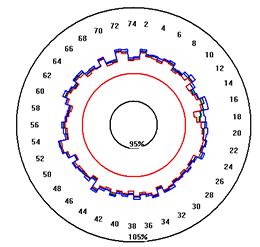Company:
Canadian Utility
Machine Description:
Hydrogenerator, 13.8 kV, 47 MW, 74 pole
Importance of Two Algorithms Use in Detection of Shorted Turns on Salient Pole Machines:
Flux monitoring via permanently installed air gap flux probes is a proven technology used for many years in synchronous machines to determine presence of turn-to-turn shorts in a rotor winding. This information is critical in planning maintenance and vibration analysis. Originally used only on high speed round rotor turbo-generators, this technology is now used on hydro-generators and motors as well. Due to larger rotor diameters and possibility that rotor shape is not completely round, the voltage induced in flux probe will be affected by electrical as well as mechanical factors. Consequently, for reliable shorted turns detection, proper identification of impact of each factor on measurement result is required.
High level of vibration has been detected on 74 pole hydrogenerator after refurbishment which included removal and re-installation of all rotor poles. Vibration would appear as soon as rotor winding was excited and an assumption was made that shorted rotor winding turns could be the reason for this. Off line testing (pole drop) did not identify rotor winding shorted turns and on-line test were performed using Iris TF Probe installed on the core and portable RFA-S Analyzer. Measurements were made at different loads and the same set of results is used for displays in Figures 1 and 2. Using polar graphs and comparing all poles to their adjacent pole, no indication of shorted turns is visible, see Figure 1.

Figure 1. Comparison to adjacent pole
Results acquired at different loads (from 0-40 MW) are shown and all poles in all tests were between 99 and 101% of their adjacent pole reading. The scale on the graph is from 95 to 105% and the red, alert circle is on 98%. Results shown in Figure 1 are consistent at all loads from 0 to 40 MW and did not indicate the presence of shorted turns. On a pole with a shorted turn, the number of active turns will be reduced and voltage induced in a flux probe will be lower for that pole, compared to other poles.
Using the same set of data, and different algorithm, comparing each pole to average of all poles, Figure 2, it is easy to see very different flux values per pole, indicating that poles are not at the same distance from the core. This is an indication that rotor is not round and as a result, uneven magnetic pull is created causing significant rotor vibrations. Similarly to the results shown in Figure 1, there was no change with change of load, all loading conditions produced the same pattern.

Figure 2. Comparison to average of all poles
Conclusion:
Use of multiple algorithms is required to eliminate the influence of variable air gap on measurement of magnetic flux. It has been demonstrated that it is possible to detect shorted turns in salient pole rotor windings without requirement to install air-gap monitoring system.

